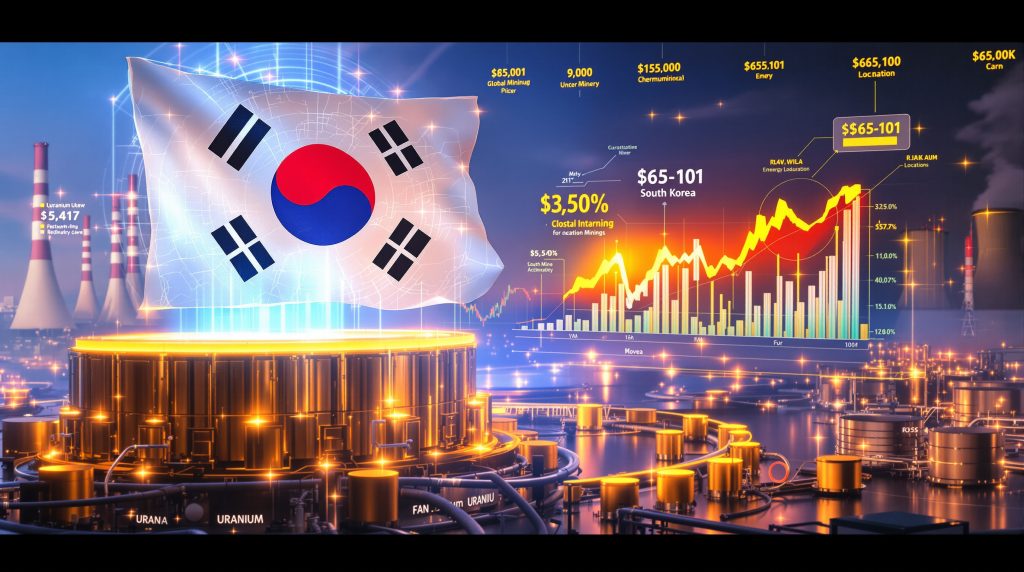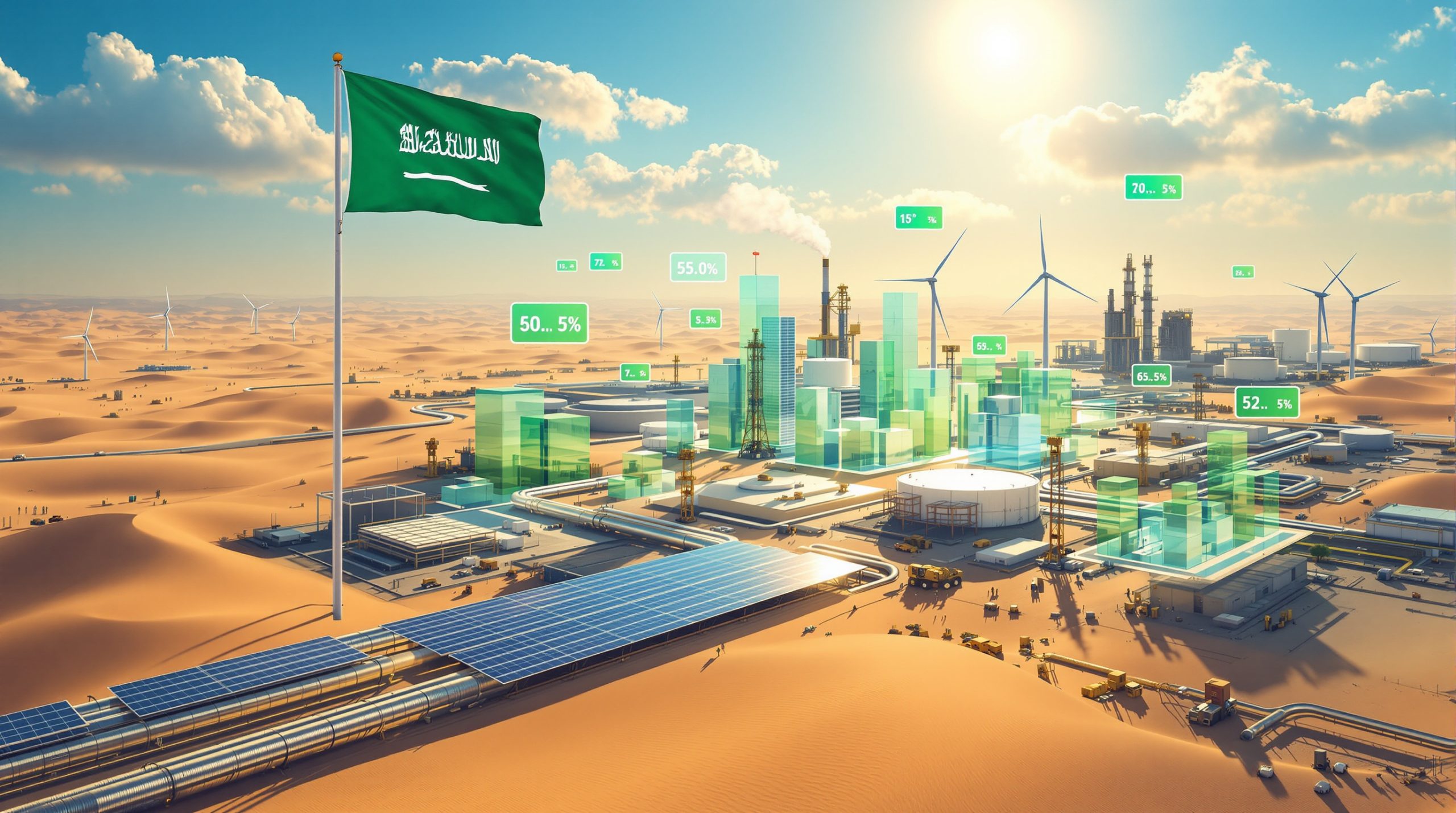South Korea's Uranium Tender: Market Implications and Strategic Analysis
South Korea's recent uranium procurement strategy has sent ripples through the global nuclear fuel market, potentially signaling a shift in how utilities approach long-term contracting. This tender represents a significant development in the uranium market during a traditionally quiet summer period, with implications for producers, utilities, and investors alike.
Key Tender Details and Market Context
The South Korean uranium tender requests 8.8 million pounds of uranium over a 10-year period from 2027 to 2036, structured as approximately 880,000 pounds annually. The terms specify 70% market-referenced pricing with floors capped at $65/lb and ceilings at $101/lb, alongside a 30% fixed-price component without a specified ceiling.
This procurement effort comes during a historically slow contracting period, with industry data showing only about 30 million pounds secured in the term market year-to-date—representing merely 25% of the typical replacement rate needed by utilities.
The timing of this tender is particularly noteworthy, occurring earlier than Korea's typical mid-Q3 schedule, potentially indicating increased urgency in securing future uranium supplies amid uranium market volatility.
Why Is South Korea's Approach to Uranium Procurement Unique?
South Korea's procurement methodology stands apart from industry norms in several key ways. While most utilities issue requests for proposals (RFPs) to test market conditions, Korea Hydro & Nuclear Power (KHNP) takes a more direct approach by dictating specific terms upfront.
This distinctive strategy includes publishing tender details publicly rather than negotiating privately, establishing price parameters before receiving bids, setting explicit floor and ceiling prices for market-referenced portions, and maintaining a consistent annual procurement schedule.
Historical Context and Previous Tender Outcomes
This isn't South Korea's first attempt at this procurement strategy. In 2023, KHNP issued a similar tender with comparable terms relative to then-current market prices. That tender received no bids, forcing KHNP to eventually negotiate off-market in early 2024 under different terms.
Market analysts note this established pattern may be repeating, with the current tender following similar structural elements but coming earlier in the year than usual. The 2023 "no-bid" outcome was widely considered a significant market signal that helped catalyze uranium price movements in late 2023 and early 2024.
What Are the Current Market Dynamics in Uranium Contracting?
The uranium term market has experienced unusually low activity in 2024, with current contracting levels representing only about one-quarter of the replacement requirements needed by utilities. This contracting slowdown comes despite steady upward pressure on prices.
Term Market Activity and Producer Expectations
Major producers have established clear parameters for the contracts they're willing to sign. Industry leaders have publicly stated their contracting requirements include:
- Preference for market-referenced contracts with floors in the $70s/lb
- Ceiling prices in the $120-130/lb range
- Reluctance to accept terms below production costs
- Long-term price protection mechanisms
These requirements reflect producers' need to secure sustainable economics for both current operations and future mine development projects.
The Gap Between Buyer and Seller Expectations
South Korea's tender terms reveal a significant disconnect between buyer expectations and seller requirements:
| Contract Element | South Korea's Terms | Major Producer Requirements |
|---|---|---|
| Floor Price | $65/lb maximum | $70s/lb minimum |
| Ceiling Price | $101/lb maximum | $120-130/lb range |
| Fixed Component | 30% (price unspecified) | Variable based on long-term price |
| Contract Length | 10 years (through 2036) | Flexible, with escalators |
This gap highlights the current tension in the uranium market between utilities seeking price protection and producers requiring sustainable economics for future production, especially considering the long-term nature of these contracts and potential production cost increases over time.
Who Can Fulfill Large-Scale Uranium Supply Contracts?
The scale of South Korea's tender (880,000 pounds annually) limits potential suppliers to a small group of established producers with sufficient production capacity and delivery capabilities.
Limited Pool of Capable Suppliers
The global uranium market features relatively few producers capable of fulfilling large-scale, long-term contracts:
- Cameco
- Orano
- Uranium One
- Kazatomprom
- Paladin
Notably absent from potential suppliers are trading companies, which typically lack sufficient offtake agreements to guarantee delivery over such extended periods, and BHP, which historically focuses on spot and shorter-term contracts rather than decade-long commitments.
Production Capacity Constraints
Even among major suppliers, production capacity faces significant challenges over the proposed contract period:
- Cameco's Cigar Lake mine is scheduled to deplete before the end of the contract period (2036)
- Kazatomprom, despite being the world's largest producer, faces production constraints and has acknowledged challenges in significant production increases
- New mine development timelines often extend 7-10 years, requiring producers to have projects already in advanced stages
- Rising production costs over the 10-year period create economic risks for fixed-price components without escalators
These constraints underscore why producers are increasingly reluctant to lock in long-term contracts without adequate price protection mechanisms. Furthermore, recent Paladin Energy updates regarding operational challenges highlight the difficulties faced by even established producers.
What Are the Implications for Uranium Price Trends?
If South Korea's tender receives no bids as industry observers expect, it could serve as a significant market signal with several potential implications.
Market Signals and Potential Price Catalysts
A "no-bid" outcome would demonstrate:
- Producer discipline in maintaining price requirements
- The reality of current production economics
- A clear signal to other utilities about prevailing market conditions
- Potential acceleration of utility procurement decisions
This situation parallels what occurred following the 2023 Korean tender, which contributed to uranium price movements in Q3-Q4 2023, when spot prices rose from the $50s/lb to over $90/lb within months.
Current Price Environment
The spot uranium price currently trades around $72/lb, approximately $8 below the term price of $80-82/lb. This relationship creates conditions for:
- Potential carry trades when the price spread is sufficient
- A natural floor in the spot market as traders purchase material for future delivery
- Limited downside risk without broader US market disruption
Industry analysts point to this price relationship as evidence of a maturing market with increasing discipline among producers, particularly given historically low secondary supply sources and depleting above-ground inventories.
How Is the Nuclear Renaissance Affecting Uranium Demand?
The global outlook for nuclear energy continues to strengthen, creating a positive long-term demand picture for uranium fuel.
Nuclear Energy Policy Shifts
Several significant policy developments are reshaping the nuclear landscape:
- Department of Energy leadership has made nuclear expansion a top priority in the United States
- Regulatory reforms are accelerating project timelines and reducing bureaucratic obstacles
- States previously opposed to nuclear energy are reconsidering new builds
- Data center energy demands are driving interest in reliable baseload power
- Public sentiment toward nuclear energy has improved significantly
These shifts represent a marked change from the post-Fukushima environment, when nuclear energy faced heightened scrutiny and accelerated plant closures.
Specific Nuclear Development Initiatives
Recent announcements highlight growing nuclear interest across various sectors:
- Denver International Airport exploring small modular reactor (SMR) development for power resilience
- Texas planning data center campuses with nuclear power components
- New York State investigating advanced reactor options, a remarkable shift after shutting down Indian Point in recent years
- Dozens of states actively considering new nuclear builds to meet growing electricity demand
These initiatives reflect the growing recognition that meeting future electricity demands, particularly from AI and data centers, will require significant baseload power capacity that nuclear energy can provide. The US uranium import ban adds further complexity to this evolving landscape.
What's Happening in the Uranium Equities Market?
The uranium investment landscape shows significant performance divergence across different segments of the market, creating both challenges and opportunities for investors.
Performance Divergence Among Uranium-Related Stocks
Different segments of the uranium market have performed quite differently:
| Segment | Performance Trend | Key Drivers |
|---|---|---|
| Major Producers (e.g., Cameco) | Strong outperformance | Vertical integration, institutional interest |
| Nuclear Technology (e.g., SMRs) | Significant gains | Policy support, retail interest, momentum trading |
| Junior Miners | Underperformance | Commodity price sensitivity, development timelines |
| Physical Uranium Trusts | Trading at discount | Awaiting spot price catalysts |
This divergence reflects the multifaceted nature of the nuclear fuel cycle and the different risk-reward profiles of various market segments.
Investment Considerations
The current market structure creates potential opportunities:
- Physical uranium vehicles may offer favorable risk-reward as spot prices remain stable with limited downside
- Uranium miners could benefit more directly from price movements than nuclear technology stocks
- The sector may experience rotation as different catalysts activate
- Vertical integration across the fuel cycle appears increasingly valuable to investors
Analysts note that while uranium prices have remained relatively flat year-to-date, select uranium equities have still delivered strong returns, suggesting potential for broader sector performance when uranium prices begin moving upward again. For those interested in capitalizing on these trends, various uranium investment strategies offer different approaches to market exposure.
What Supply Challenges Could Impact Future Uranium Markets?
The uranium market faces several unique supply challenges that differentiate it from other commodity markets and could impact future price dynamics.
Declining Secondary Supply Sources
Historical uranium markets benefited from significant secondary supply sources that have largely disappeared:
- "Megatons to Megawatts" program (1993-2013) provided 20 million pounds annually from Russian downblended weapons material
- Underfeeding from enrichment has declined from approximately 30 million pounds to 10-15 million pounds
- Above-ground mobile inventory from previous oversupply has been depleted
These changes mean the market must increasingly rely on primary production to meet demand, creating less elasticity in supply response.
Production Challenges and Constraints
Future supply must increasingly come from primary production, facing several challenges:
- Limited skilled operators capable of building complex uranium mines
- Declining production at existing operations (like Cigar Lake)
- Development timelines for major projects often extending 7-10 years
- Potential for supply disruptions with limited inventory buffers
- Geopolitical concentration of production in regions like Kazakhstan
Industry experts point to large projects like NextGen's Arrow development as critical to future supply adequacy, with any delays potentially creating significant market impacts.
Industry Consolidation Needs
The sector likely requires further consolidation to optimize development:
- Limited pool of skilled uranium mining operators necessitates resource sharing
- Need for capital efficiency in development of complex projects
- Potential for mergers and acquisitions to optimize project development timelines
- Vertical integration benefits for managing supply chain risks
Recent examples like Paladin's acquisition of Fission Uranium highlight this consolidation trend, which may accelerate as development timelines become more critical.
What Should Investors Watch for in the Uranium Market?
Several indicators may signal future market movements and provide insights for investors monitoring this space.
Key Market Indicators
Investors should monitor:
- Term market activity levels, particularly during traditionally quiet periods
- Outcomes of public tenders like South Korea's
- Development timelines for major projects like Arrow
- Utility contracting behavior as budgets refresh
- Nuclear policy developments in key markets
- Inventory levels at utilities and producers
These indicators can provide early signals of changing market dynamics before they're fully reflected in spot prices.
Seasonal Patterns and Near-Term Outlook
Historical patterns suggest potential catalysts ahead:
- World Nuclear Association (WNA) conference in coming weeks often serves as a gathering point for industry participants
- Seasonal strength in utility procurement typically follows budget cycles
- New fiscal year budget approvals often trigger contracting activity
- Winter months historically show stronger contracting patterns
Market observers note that August activity in the term market is particularly unusual and may signal accelerating procurement interest among utilities ahead of the typical seasonal cycle.
The uranium market remains poised at an interesting inflection point where the transition from secondary to primary supply sources, combined with growing nuclear energy interest, creates potential for continued price discovery and market evolution.
Ready to Capitalise on the Next Mineral Discovery?
Discover significant ASX mineral discoveries as they happen with Discovery Alert's proprietary Discovery IQ model, which transforms complex data into actionable insights for traders and investors. Explore how historic discoveries can generate substantial returns by visiting Discovery Alert's dedicated discoveries page and begin your 30-day free trial today to position yourself ahead of the market.




